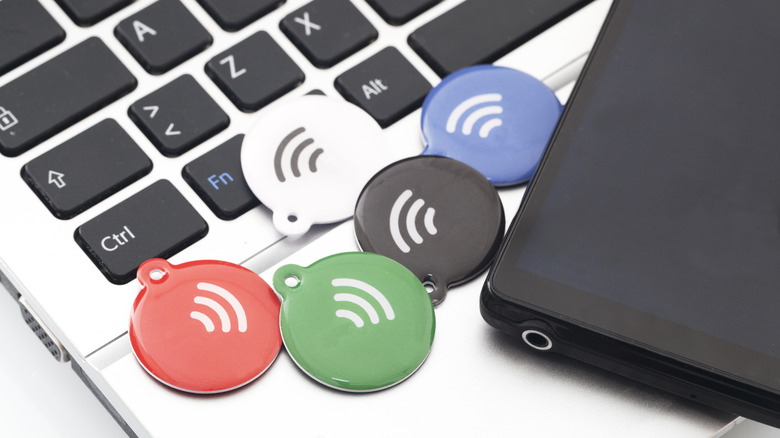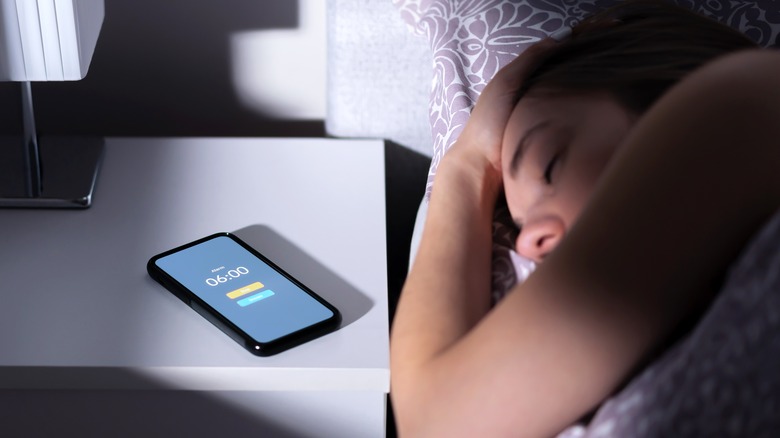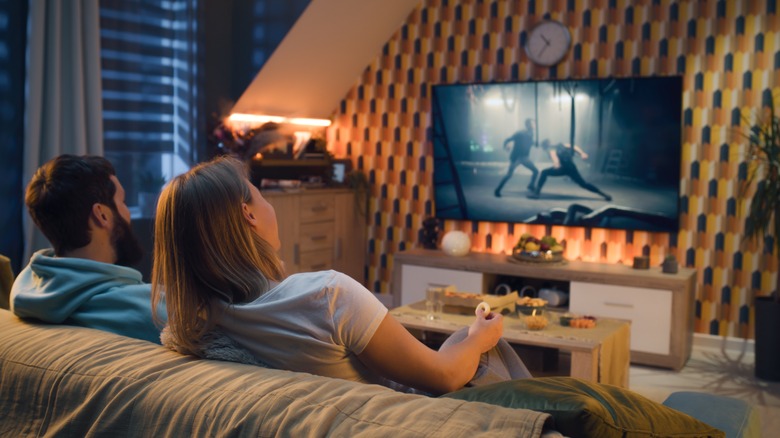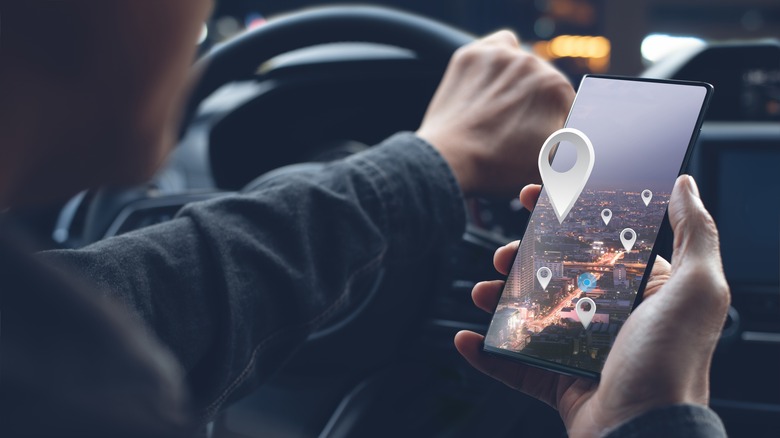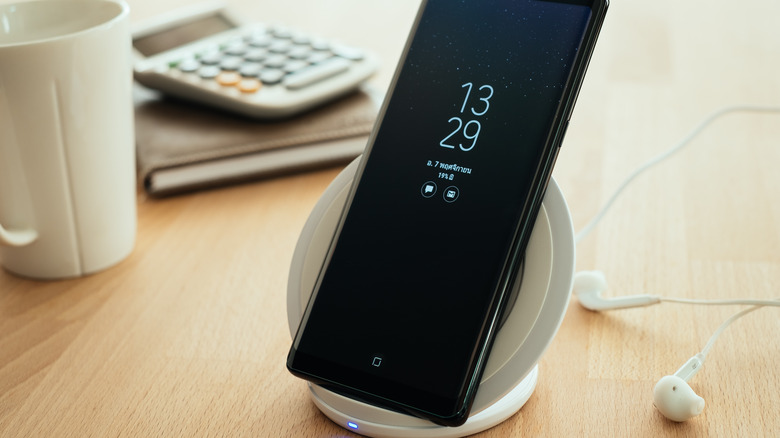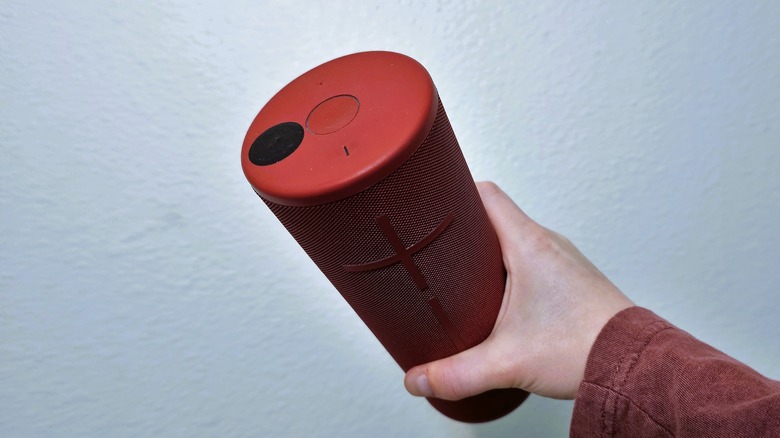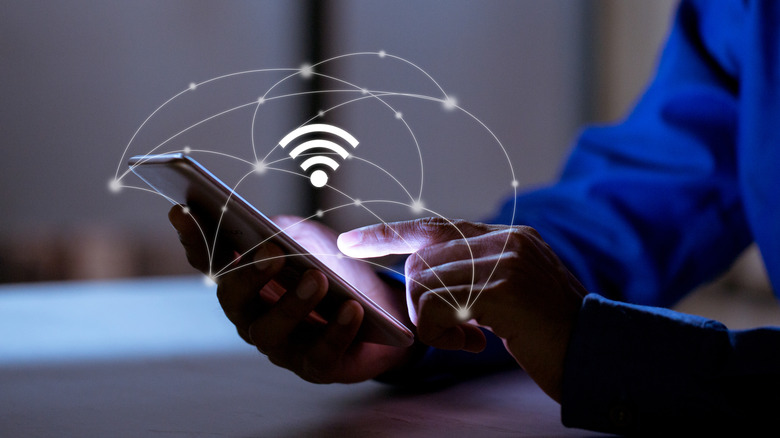The Coolest Ways To Use NFC On Your Android Phone
By now, most people are used to the idea of tapping your phone to a payment terminal to complete a transaction. It feels like living in the future to pay for a pint of Ben & Jerry's with your phone. And in New York City, subway riders can now tap their phone to enter a Metro platform. But the technology powering that futuristic checkout experience has been with us for a while. It's called NFC, which stands for near-field communication, and it has infinite applications on Android beyond being a fancy new way to spend your money.
NFC is nifty because it's a relatively simple technology that unlocks some powerful solutions to everyday problems. It works by using tags and devices that can read them. The tag is made up of an incredibly thin copper coil wrapped around a microchip, which can store small amounts of data. The reader is most commonly a smartphone.
Android phones have been equipped with NFC for over a decade, since the Samsung Nexus S phone was released in 2010, but the Panasonic P506iC had that capability all the way back in 2004. Let's be gentle to our good comrades with iPhones, who only got this Bush-era technology in 2014. In fairness to Apple, its adoption of the technology is likely what helped NFC to achieve its current ubiquity in American payment terminals.
Though NFC may be an aging technology, its usefulness has only increased over the years. Today, you can turn yourself into a minor superhero using nothing but your Android phone and a pack of NFC stickers which will run you less than $10. Here are some of the coolest ways to implement NFC in your life.
NFC tasks: The basics
In order to get the most out of NFC technology, you'll first need a set of NFC tags, to state the obvious. Equally important, you'll need an app on your NFC-enabled Android phone capable of reading NFC tags and executing routines of varying complexity.
If you own a newer Samsung Galaxy phone running One UI 5.0 or above, you're in luck: Your device comes with Samsung's Modes and Routines app preinstalled, and it provides a user-friendly way to easily create if/then scenarios that can be triggered via NFC, along with impressive access to Samsung's suite of apps, settings, and features. For everyone else, or for those who want to get a bit more granular with their NFC controls, a few options are available.
One of the most popular apps for this purpose is NFC Tools. To use it for NFC tasks, you'll need to install its companion app, the aptly named NFC Tasks. The developer even has a handy YouTube playlist explaining how to use the app. A handful of other apps will get the job done as well, and you can integrate them with a larger constellation of apps like Trigger, Tasker, or IFTTT for even more functionality. Whichever you pick, you'll need to set it up by giving it access to a laundry list of permissions, which will enable the app to control your phone when triggered by an NFC tap.
Once you have your preferred NFC tasks app set up and running, you're ready to begin automating your life with NFC.
Get ready for bed without getting out of it
Have you ever snuggled under the covers at night only to remember that you forgot to turn off the downstairs lights or adjust the thermostat? There's nothing worse than having to leave the warmth of your bed and amble around the house. Okay, there are a lot of worse things, but it sucks.
Lucky for you, NFC is more than able to solve that problem, provided you've invested in a smart home setup. Simply stick an NFC tag on the spot you tend to put your phone at bedtime, then set up a bedtime routine to be triggered when you do so. You may wish to set alarms for the morning, turn off the lights across your entire home, set your smart thermostat to a certain temperature, and pause your notifications. If you're the kind of person who falls asleep to nature sounds, white noise, or music, you can have that audio cue up from apps that support it, and even connect to a particular Bluetooth speaker. And if you're in the habit of sending a "goodnight" text to any of your loved ones, you can automate that, too.
As with many suggestions in this list, bedtime routines for NFC can be extra convenient when the tag is placed on a wireless charging pad. Just drop your phone on the charger and your head on the pillow.
Get yourself out of bed in the morning
Is anyone actually a morning person? For those who answer with an emphatic, "Hell no!" NFC can be the perfect way to drag yourself out from under the covers. If you use your Android phone as an alarm clock, it's all too easy to tap the "dismiss" button and get back to that sweet dream you were having. (You know, the one where you managed to get your hands on a new gadget that you can't wait to review for SlashGear. Is that just us?) Over the years, we've seen alarm apps that make you do math, solve puzzles, or shake your phone for several minutes before it shuts up. But speaking from experience, you can go right back to sleep after doing math.
With NFC tags, you can make your alarm force you out of bed. Some alarm apps (Sleep as Android is among the most popular) can take advantage of NFC to make you scan a tag before they will shut off. Put that tag near your coffee machine or in the bathroom and you'll be forced in that direction when it's time to wake up.
While you're there, you might consider adding a second tag next to the alarm disabling one. This can be set to initiate a morning routine that turns on the lights, plays your favorite news briefing, and more.
Leave home with away routines
Getting out of the house can be a never-ending to-do list, but with the power of NFC, you can bend your house or apartment to your will with a single tap ... assuming you've already invested in a smart home setup. NFC isn't the only way to automate your home, but it may be the most reliable. Smart home apps on Android commonly use geolocation perimeters to detect when you've left home, or timers you can base on your common routines. But the former option requires giving those apps location permissions and having your GPS enabled, which risks privacy and drains your phone's battery. With NFC, all you need to do is remember to tap your phone to the tag or sticker when you leave.
Put an NFC tag on or near your front door and set it to trigger a routine that turns off lights, TVs, and air conditioning. If you have smart appliances like dishwashers or washing machines, you can trigger them to start as well. And, of course, if there's anything else you need done before leaving and that can be automated for your own personal needs, you can add them to the same routine.
Set modes for work, entertainment, and more
NFC stickers are dirt cheap. You can get dozens of them for less than the cost of a breakfast bagel, so there's no reason not to slap a few in various places of convenience around your home and office, especially in rooms that tend to be used for specific purposes.
For instance, you can set an NFC-triggered routine to turn on Do Not Disturb mode, which itself can be configured to allow only notifications from work apps like Slack, and attach it to your desk at work. You can put one on the table in your home theater set to dim the lights and fire up your TV or jump straight into Netflix (the latter of which can be accomplished with a Google Assistant command if you have a smart home-enabled TV). Or, you can set a routine to start timers, fire up a podcast, or start smart kitchen appliances while you're cooking. One savvy Reddit user even created a laminated chart full of NFC tags to trigger various kitchen-related activities.
We've got even more helpful suggestions to NFC-ify your home in our list of the best around-the-home uses for NFC.
Make your drive a breeze
Are you wasting time each time you get in your car by cuing up podcasts and getting to your navigation app before you actually pull out of the garage? All that extra work can be circumvented with a single NFC sticker. Wherever you normally dock your phone, simply stick an NFC tag in that spot and set it to automate your phone's driving related functionality.
For instance, you can set things up so that, when you dock your phone in the car, it automatically launches Spotify and turns the volume to your preferred level, then opens Google Maps with a route set to your home and turns up your screen brightness so you can see the map. For cars with finnicky Bluetooth systems, you can append a step to the beginning of the routine that automatically connects your phone to that device. And for truly distraction free driving, you can turn on Do Not Disturb mode.
For even more convenience, you can set another routine to trigger every time your phone disconnects from your car's Bluetooth, reverting all the changed settings back to normal when you're done driving.
Take advantage of charge time
The harsh reality of current smartphones is that they use a lot of power. Whereas the comparatively less smart flip phones of the pre-smartphone era could often last for days, if not weeks on a charge, even the best smartphones struggle to last more than a single day with heavy use. That's why it can be incredibly useful to have your Android phone complete some of its most intensive tasks while connected to power. And you can batch many of them together by putting an NFC tag on the spot you usually drop your phone while charging it, then assigning that tag to trigger a routine.
There are some tasks, like auto-updating your Play Store apps, that are already set to trigger when your phone has been charging, but you may find it useful to trigger additional ones with NFC. For example, you can connect to a specific Wi-Fi network while charging so those app updates don't gobble up your mobile data, or you can trigger certain cloud storage services to back up your device.
Exercise without interruption
For cycling, hiking, climbing, and more, you may enjoy listening to music while using an app like Strava or Google Fit to track your activity on Android. However, you probably don't enjoy fiddling with your phone for minutes at a time when all you really want to do is get your blood pumping.
From NFC Tools, you can make Strava open to the Record page when you tap a programmed NFC tag, while on Samsung Modes and Routines, the best you can do is open the app itself. On both, however, you can also cue up Spotify playlists and turn on Do Not Disturb. If you're a cyclist, you can grab a bike mount for your phone and place the tag there. Or you can attach one to your hiking pack, climbing gear, or ski helmet. The options are pretty much limitless, so you'll just need to consider the best use case for your particular sport.
If your workouts take place inside a gym rather than the great outdoors, consider putting an NFC tag in your locker to silence notifications or cue up your workout mix.
Make a dumb Bluetooth speaker smarter
Bluetooth speakers have become ubiquitous items found in almost every home, and for good reason. They're incredibly portable, reasonably inexpensive, and often rugged ways to experience audio that sounds better than your phone's speakers wherever you like. But some Bluetooth speakers are more convenient than others. For example, certain models of speakers come equipped with embedded NFC tags that will automatically connect your phone to the speaker when tapped. This simple feature circumvents the tedious process of putting the speaker in pairing mode and finding it in your phone's Bluetooth menu to connect. It's one tap and done, and it's the sort of feature you won't think is important until you've experienced it and then have to live without it.
However, you can add precisely that functionality to any Bluetooth device, from speakers to keyboards, using a dirt-cheap NFC tag. Simply use your NFC reading and writing app to write that Bluetooth connection onto a tag, then stick that tag on a smooth, flat surface of the device. It's an easy way to make your Bluetooth devices a little bit smarter and a lot more convenient.
Easily let guests connect to your Wi-Fi
How many times have you had to check the label on your router when a guest asks for your home Wi-Fi password? Even if you know it by heart, it can be a pain to relay when you find yourself saying things like, "Okay, so the first 'O' is a zero and the second 'I' is capitalized."
It may be time to put those days of analog communication behind you with NFC by writing a tag to automatically connect devices that scan it directly to your Wi-Fi network. Not only does it simplify things for both you and your guests, but this simple hack is also an impressive party trick. When your friends simply tap their phone to your coffee table and are instantly given the gift of an internet connection, their jaws will drop.
The one caveat here is that this won't work for your iPhone-owning guests, at least until Apple decides to build that functionality into iOS.
